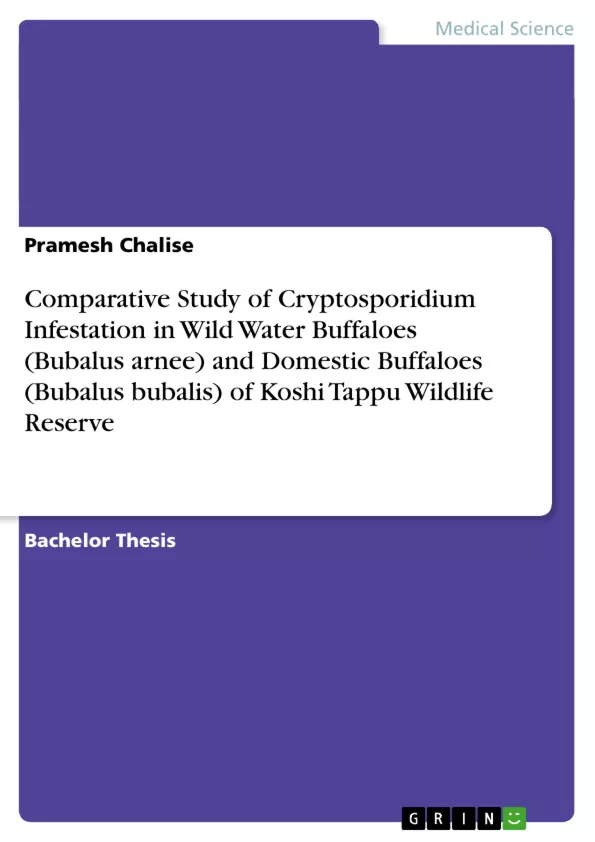Blick ins Buch

Comparative Study of Cryptosporidium Infestation in Wild Water Buffaloes (Bubalus arnee) and Domestic Buffaloes (Bubalus bubalis) of Koshi Tappu Wildlife Reserve
Bachelorarbeit, 2013
31 Seiten, Note: Final
Leseprobe
Inhaltsverzeichnis (Table of Contents)
- Introduction
- Background
- Classification
- Pathogenesis
- Epidemiology
- Transmission pattern
- Justification of the study
- Background
Zielsetzung und Themenschwerpunkte (Objectives and Key Themes)
This study aims to determine the prevalence of Cryptosporidiosis in wild water buffalo in Nepal. The study addresses a knowledge gap in the field and contributes to conservation efforts by focusing on a vulnerable population. The study highlights the importance of understanding protozoan parasite infestations in both wild and domesticated buffalo populations, which can impact the health and survival of young calves. Key themes include:- Prevalence of Cryptosporidiosis in wild water buffalo in Nepal
- Impact of Cryptosporidiosis on animal health and survival
- Zoonotic transmission and potential public health risks
- Conservation efforts for vulnerable wild water buffalo populations
Zusammenfassung der Kapitel (Chapter Summaries)
Introduction
This section provides a comprehensive overview of Cryptosporidium species, their life cycle, and their impact on both human and animal health. It delves into the classification, pathogenesis, epidemiology, and transmission patterns of Cryptosporidium, highlighting the importance of understanding this zoonotic pathogen.Justification of the Study
This section justifies the need for this study, emphasizing the absence of previous research on Cryptosporidiosis in wild water buffalo in Nepal. The study aims to bridge this knowledge gap and contribute to conservation efforts by focusing on a vulnerable population.Schlüsselwörter (Keywords)
Cryptosporidiosis, Cryptosporidium, wild water buffalo, Nepal, zoonotic, prevalence, animal health, conservation, pathogenesis, epidemiology, transmission, public health.
Ende der Leseprobe aus 31 Seiten
- nach oben
Details
- Titel
- Comparative Study of Cryptosporidium Infestation in Wild Water Buffaloes (Bubalus arnee) and Domestic Buffaloes (Bubalus bubalis) of Koshi Tappu Wildlife Reserve
- Veranstaltung
- Veterinary science
- Note
- Final
- Autor
- Pramesh Chalise (Autor:in)
- Erscheinungsjahr
- 2013
- Seiten
- 31
- Katalognummer
- V271150
- ISBN (Buch)
- 9783656621423
- ISBN (eBook)
- 9783656621447
- Dateigröße
- 2618 KB
- Sprache
- Englisch
- Schlagworte
- comparative study cryptosporidium infestation wild water buffaloes bubalus domestic koshi tappu wildlife reserve
- Produktsicherheit
- GRIN Publishing GmbH
- Preis (Ebook)
- US$ 16,99
- Preis (Book)
- US$ 18,99
- Arbeit zitieren
- Pramesh Chalise (Autor:in), 2013, Comparative Study of Cryptosporidium Infestation in Wild Water Buffaloes (Bubalus arnee) and Domestic Buffaloes (Bubalus bubalis) of Koshi Tappu Wildlife Reserve, München, Page::Imprint:: GRINVerlagOHG, https://www.diplomarbeiten24.de/document/271150
Allgemein
Autoren
- Autor werden
- Ihre Optionen
- Vertriebskanäle
- Premium Services
- Autorenprofil
- Textarten und Formate
- Services für Verlage, Hochschulen, Unternehmen
Premium Services
FAQ
Marketing
Dissertationen
Leser & Käufer
Zahlungsmethoden

Copyright
- © GRIN Publishing GmbH.
- Alle Inhalte urheberrechtlich geschützt. Kopieren und verbreiten untersagt.
- info@grin.com
- AGB
- Open Publishing
Über GRIN
Der GRIN Verlag hat sich seit 1998 auf die Veröffentlichung akademischer eBooks und Bücher spezialisiert. Der GRIN Verlag steht damit als erstes Unternehmen für User Generated Quality Content. Die Verlagsseiten GRIN.com, Hausarbeiten.de und Diplomarbeiten24 bieten für Hochschullehrer, Absolventen und Studenten die ideale Plattform, wissenschaftliche Texte wie Hausarbeiten, Referate, Bachelorarbeiten, Masterarbeiten, Diplomarbeiten, Dissertationen und wissenschaftliche Aufsätze einem breiten Publikum zu präsentieren.
Kostenfreie Veröffentlichung: Hausarbeit, Bachelorarbeit, Diplomarbeit, Dissertation, Masterarbeit, Interpretation oder Referat jetzt veröffentlichen!
- GRIN Verlag GmbH
-
- Nymphenburger Str. 86
- 80636
- Munich, Deutschland
- +49 89-550559-0
- +49 89-550559-10
- info@grin.com
-









